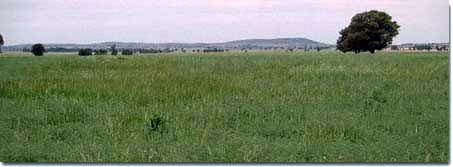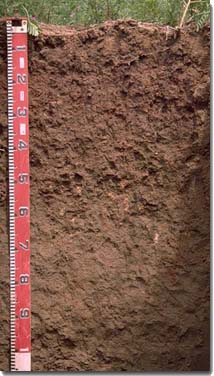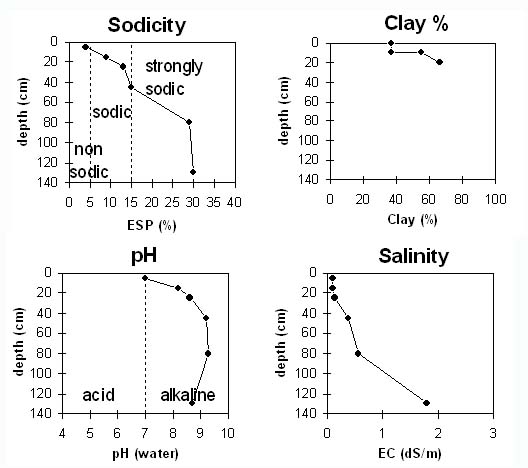Site LP92
Location: Gooroc
Australian Soil Classification: Epicalcareous-Epihypersodic, Crusty, Brown VERTOSOL
Northcote Factual Key: Ug 5.3
Great Soil Group: brown clay
General Landscape Description: Level plain with gilgai ('crabholey') microrelief.
 Site LP92 Landscape |
Soil Profile Morphology:
Surface Soil
| A1 | 0-10 cm | Dark reddish brown (5YR3/4); light medium clay; moderate coarse blocky structure; strong consistence dry; pH 7.0; clear change to: |  Site LP92 Profile |
| Subsoil | |||
| B21 | 10-20 cm | Reddish brown (5YR4/4); medium clay; moderate coarse prismatic, parting to strong coarse blocky structure; weak consistence moist; pH 8.2; clear change to: | |
| B22 | 20-30 cm | Dark reddish brown (5YR3/4); medium heavy clay; moderate coarse prismatic, parting to strong coarse blocky structure; very firm consistence dry; pH 8.6; clear change to: | |
| B31k | 30-70 cm | Brown (10YR4/3); medium heavy clay; moderate coarse blocky, parting to moderate medium polyhedral structure; firm consistence moist; contains angular quartz (20 mm size) and a few (2-10%) carbonates; pH 9.2; gradual change to: | |
| B32 | 70-100 cm | Brown (10YR4/3); medium heavy clay; moderate medium polyhedral, parting to strong fine polyhedral structure; slickensides evident; firm consistence moderately moist; contains gypsum crystals (< 2 mm size), ironstone nodules and quartz fragments; pH 9.3; gradual change to: | |
| B33 | 100-150 cm | Brown (10YR5/3); light clay; moderate structure; firm consistence moderately moist; pH 8.7. | |
Key Profile Features:
- High clay content throughout soil profile.
- Vertic properties (i.e. significant shrink-swell characteristic).
Soil Profile Characteristics:
pH | Salinity Rating | |||
Surface (A1 horizon) | neutral | very low | non-sodic | none1 |
Subsoil (B21 horizon) | moderately alkaline | very low | sodic | strong |
Deeper subsoil (at 1 m) | strongly alkaline | high | strongly sodic | - |

Management Considerations:
Whole Profile
- Plant available water capacity (PAWC) is considered to be low-medium (estimated at 100 mm). This is based on available laboratory data and assumes an effective rooting depth of 60 cm. Rooting depth will be restricted by the strongly sodic subsoil.
- The surface soil disperses completely after remoulding. This indicates that excessive cultivation of the soil when in a moist to wet condition may promote dispersion and result in soil structural degradation (e.g. surface sealing). Raindrop impact on bare soil is also likely to result in structural degradation.
- Tillage of cracking clay soils should be avoided if the soil is wet (i.e. wetter than the plastic limit). At such moisture conditions, excessive tillage, trafficking or overstocking can result in structural degradation (e.g. compaction, smearing) occurring. Ideally, tillage and trafficking should take place when the soil is drier than the plastic limit, down to at least the depth of tillage.
- The coarsely structured upper subsoil is sodic and disperses strongly. This indicates that root and water movement will be restricted in the subsoil.
- The deeper subsoil (from 20 cm depth) is strongly alkaline, which indicates that some nutrients (e.g. iron, manganese, copper, zinc) may be poorly available to plants at depth.
- The level of soluble salts becomes high in the deeper subsoil at a depth of about 1 metre and is only likely to restrict the growth of deeper rooted salt sensitive species.
- Gypsum response trial established in this paddock and gypsum applied.
- Originally this soil had to be worked separately from the rest of the paddock as it was extremely hardsetting. Since reduction in cultivation and stubble retention it can now be worked with the rest of the paddock and has darkened in colour.
- Will probably apply more gypsum next year.


